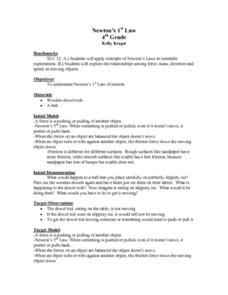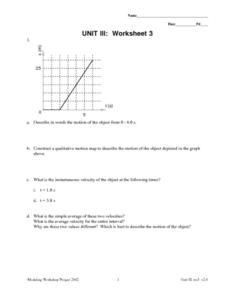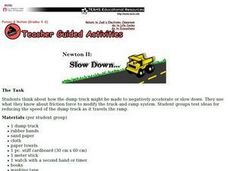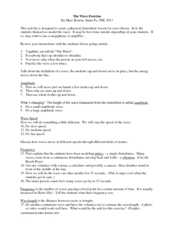Curated OER
Newton's Ist Law
Fourth graders explore Newton's First Law of Motion. They conduct an experiment to observe what happens to a ball that is placed carefully on slippery ice. They also observe what happens to a dowel on the ice, then draw and label...
Curated OER
Newton: Force and Motion
In this forces instructional activity, students use the equations for acceleration and Newton's second law to learn about different motions and forces. This instructional activity has 7 problems to solve.
Curated OER
Linear Motion 6
In this linear motion worksheet, students answer 12 questions about acceleration, velocity and distance traveled. They interpret diagrams and indicate the location of an object if it has positive, negative or no acceleration. They...
Curated OER
Linear Motion in Class Test Review
In this linear motion worksheet, students answer 21 questions about acceleration, velocity, position and time. Students interpret graphs of position vs. time, velocity vs. time and acceleration vs. time. They calculate speed of objects,...
Curated OER
Velocity and Acceleration
Compliment your physics lesson with this PowerPoint which demonstrates many important points regarding acceleration and velocity. A starter experiment activity to stimulate student thinking is given, and may prove very interesting to a...
Curated OER
Unit V: Worksheet 2 - Constant Force
Physics learners studying force and acceleration practice solving eight problems with this assignment. They calculate acceleration and deceleration, net force, and distances required for stopping a moving object. Kinematics equations and...
Flipped Math
Calculus AB/BC - Connecting a Function, Its First Derivative, and Its Second Derivative
Uncover what the first and second derivatives reveal about the function. Pupils move beyond sketching graphs to determine what derivatives tell about the function itself. The video reminds learners about particle motion and how to...
Physics Classroom
Free Fall
Scholars must understand freefall before they learn how objects like airplanes fly. They apply knowledge of velocity and acceleration to predict speed and direction as part of a larger series on vectors and projectiles.
Curated OER
Measuring Acceleration
Learners create an accelerometer and take measurements of acceleration in a moving car. They study the car speeding up in a straight line, slowing in a straight line and curving at constant speed. They prepare a lab report showing...
Curated OER
Unit III: 3
In this unit III: 3 worksheet, students describe motion in words and graph drawings. Students calculate the instantaneous velocity and average velocity. Students also graph the displacement of the object in the word problems.
Curated OER
Newton II; Slow Down
Students, in hands-on activities, explore how a dump truck might be made to negatively accelerate or slow down. They participate in activities using friction force to modify the truck-and-ramp system. Student groups test ideas for...
Curated OER
Algebra-Based Linear Motion Problems
In this motion worksheet, students determine the distance traveled, the acceleration, and velocity of different objects. This worksheet has 11 problems to solve.
Curated OER
"Fast and Slow"
High schoolers find a partner, they think about their favorite TV sport that they might like to perform in an unusual dance. They practice their chosen sport and students see if they can make a litter repeating pattern of three or four...
Curated OER
Elements of Physics: Motion, Force and Gravity
Students research about different human space explorations conducted by NASA. In this physical science lesson, students discuss why space exploration is important. They write a paper about their thoughts on continuing NASA's space...
The Science Spot
The Wave Exercise
During a lesson on wave motion, physical science participants basically act out the waves as a group. Through their movements, the amplitude, speed, frequency, and wavelength are all identified. Ideas for modeling the reflection and...
Curated OER
Understanding Newton's Laws
In this physics worksheet, students investigate Newton's Three Laws. In this multiple choice, matching, and short answer worksheet, student answer eleven questions.
Curated OER
Forces
In this forces worksheet, students read about what affects the force on an object. Students identify push forces and pull forces in 5 diagrams. They answer 13 questions about the forces in two diagrams and they draw vector diagrams to...
EZ Task
Forces
Investigate force, acceleration, Newtons, and vectors with this worksheet packet that starts with an overview fact sheet for reference. Learners label images as either push or pull forces, indicating if the force causes a change in...
Curated OER
Plate Tectonics: First Grade Lesson Plans and Activities
A set of first grade geology lessons focuses on plate tectonics and movement of plate boundaries. During the pre-lab, learners experience three types of plate movement through a kinesthetic demonstration. The lab...
Curated OER
Newton's 2nd Law
Fourth graders discuss Newton's Second Law of Motion, and the acceleration of fast and slow moving objects. They experiment with items with different masses to determine the effect mass has on acceleration using a toy car. They complete...
Curated OER
The Science of Hurricanes
Students explore hurricanes. In this science lesson, students discuss the aspects of hurricanes and watch videos of hurricanes. Students discuss the motion of the hurricanes.
Curated OER
Motions
Ninth graders differentiate between energy waves transmitted from a quarry or mine as opposed to energy waves transmitted by an earthquake. They analyze seismograms of blast events from at least two quarries or mines. The energy waves...
Colorado State University
Why Do Raindrops Sometimes Land Gently and Sometimes with a Splat?
A mouse can fall from large heights without injury! Air resistance is a large influence on small falling objects. In an exploratory lesson, young scholars build a raindrop bottle to compare the falling rate of different-sized objects.
Curated OER
Extreme Acceleration
Students explore the concept of acceleration. They determine the acceleration rate of a roller-blader and graph the results.

























